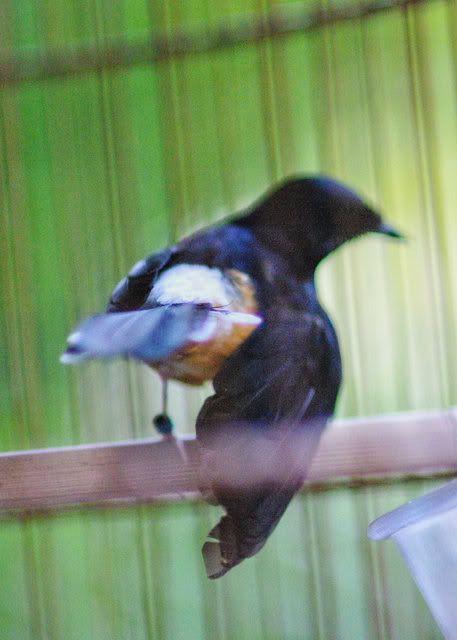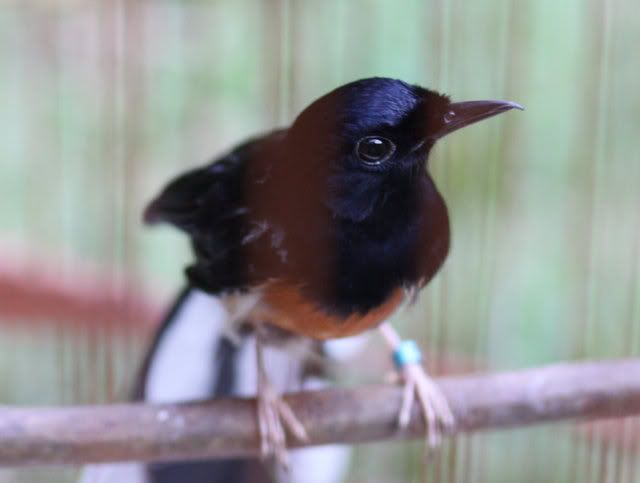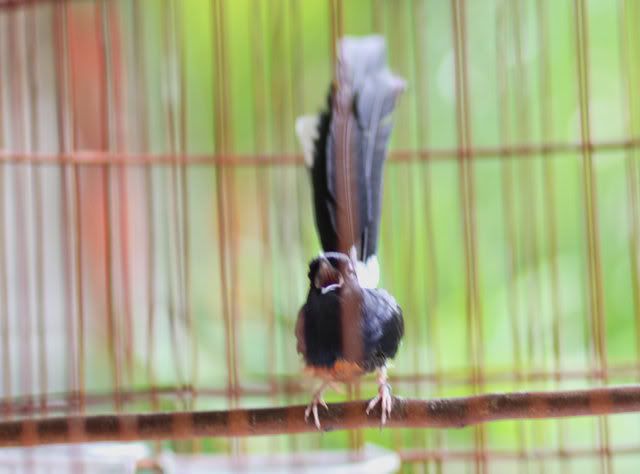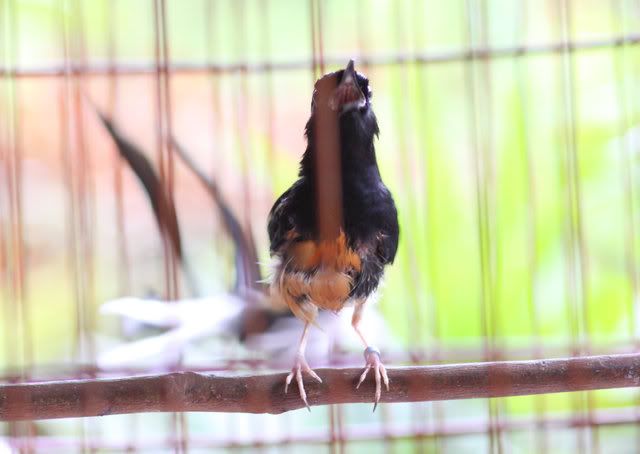I caught him and examined his wing. It was fractured. This is what he looked like:

I turned to my first source of consultation, Jeffrey Low. Jeff said that he had never had a bird the size of a shama with a broken wing but if the break was a clean fracture, the wing should be able to heal completely if it was properly bound in place. I agreed to try.
Jeffrey bought surgical tape and with one of us holding the bird, the wing was carefully put in place and then bound tightly to his body. While we were doing this, we marveled at how brave he was. For one thing, his heart was not pounding as would usually be the case with a terrified bird.
After we had bound the wing, we placed him in a small cage to restrict his movement while his wing was healing. The perch and food were placed low so that he could reach them easily. To assist in the healing, I supplemented his food with calcium for bone growth. I also gave additional vitamin E.
The medical books advise that the bandage should be kept in place for 3 to 5 weeks. They caution that immobilizing the wing for too long could result in a atrophy of the wing muscles and the loss of the bird's ability to fly. Nevertheless Jeffrey and I decided to leave the bandage in place for 6 weeks.
Last Sunday was the end of this period and we caught the bird and removed the bandage with a scissors. Whilst we tried to be as gentle as we could, it was inevitable that some of his body and wing feathers would stick to the tape and were removed with it. Eventually, we removed all the tape. Jeff timed the entire process at about half-an-hour. Again, Jeff and I marveled at how brave he was.
Jeff felt the wing and said that the fracture appeared to have healed well. We then returned the bird to his cage. He shook his feathers and appeared none the worst for wear. He did not even seem to have been in stress. He could lift his injured wing for awhile before it drooped. Jeff said that the bird's ability to lift its wing was a good sign as it showed that his wing had healed properly. He also said that and the inability to lift the wing for long was due to the weak wing muscles but with time, it should be fine.
At the time that the bird had the accident, he was part way through his moult. He had completed his body moult but his growing tails were only about 4". I expected the trauma to adversely affect his tail growth and it did. The length of his tails had previously been 13" and it is now fully grown at about 10". This doesn't bother me as his tails should grow to their full length in the next moult.
Within days of the bandage being removed, he had started to sing. It is now slightly more than a week and his condition has improved. He is able to take baths which he enjoys. Also, he is more and more able to lift his wing in place. This is what he looks like today. The photo shows his healed wing. His appearance is a little untidy but this is because some of his feathers were accidentally removed with the surgical tape. He is really a brave bird and I am happy to have him.

Update - 9th October, 2008
Below are photos I took today of the shama with the fractured wing. Jeffrey Low and I only removed the tight adhesive bandage about 1 1/2 weeks ago. The bird must have suffered severe trauma especially as the process took about 1/2 hour. Yet here he is, already displaying and singing aggressively.
It will be seen that parts of his body feathers are not there. The feathers stuck to the adhesive bandage that bound the fractured wing tight to his body and had to be removed together with the bandage. Although we tried to be as gentle as we could, there was no way the bandage could be removed without also peeling off the feathers.
The wing that fractured was his right wing. As the bird is facing you in the photos, the fractured wing is on your left. The wing looks perfect. The photos help to explain why.
After taking the photos, I released him in my study room and offered him a bathe. He flew normally and seemed to enjoy his flights. Even after taking his bathe and with wet feathers he was able to fly without much effort to a perch which is about 4 feet high. I will let him fully recover his flight muscles in his own time. I think the world of this bird and especially of his courage.



